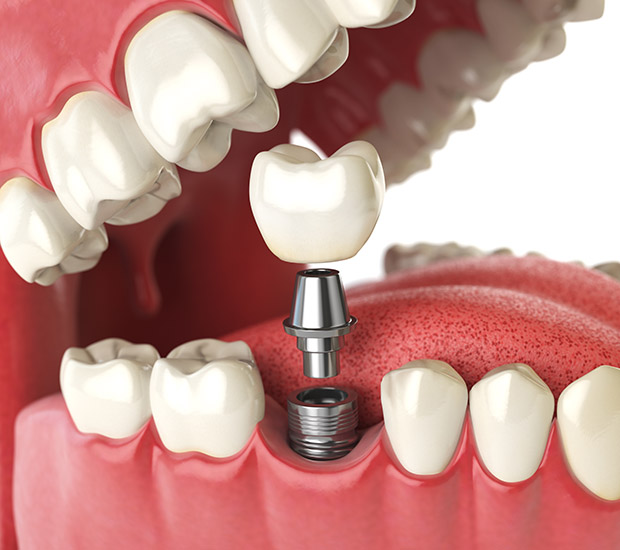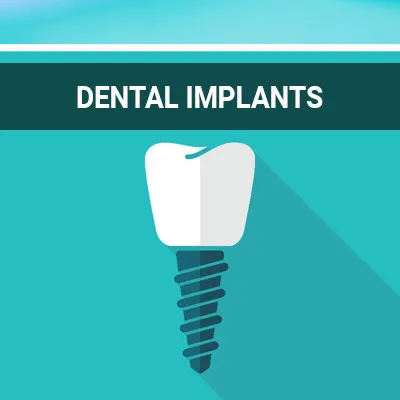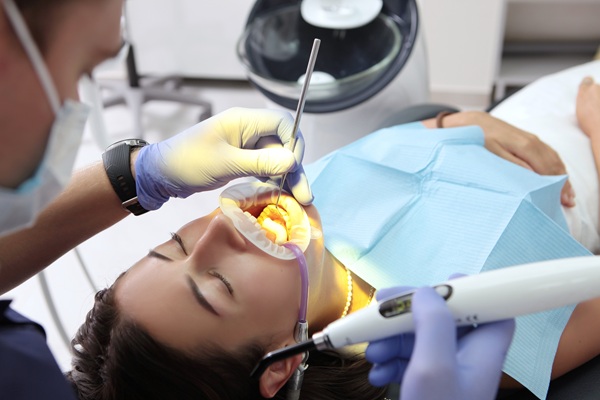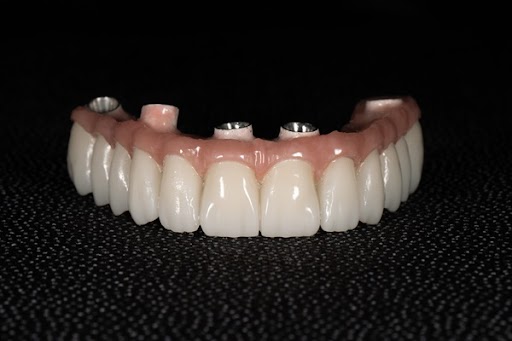Will I Need a Bone Graft for Dental Implants Modesto, CA
For people who have one or two missing teeth, dental implants are one of the most effective tooth restorations available. The implant needs support from a sufficiently thick mass of jawbone to support the dental restoration. A bone graft procedure involves transplanting bone to the implant site to make the jawbone thicker.
Bone graft procedures for dental implants are available at Great Smiles Dental in Modesto and the surrounding area. Although bone grafting is an option, it is not always necessary. If you want to know if you would need a bone graft for dental implants, call our office at (209) 222-3636 to book a consultation with Great Smiles Dental.
Jaw Mass and Dental Implants
Dental implant restoration involves the placement of titanium implants into the jawbone. Over time, the implant will fuse with the jawbone in a process known as osseointegration. This ensures that dental implants have the same function and appearance as natural teeth. However, for osseointegration to occur, the patient must have enough jawbone density to support the implants.
Bone density may diminish due to resorption. After tooth loss, the bone in that area can resorb by up to 25 percent within the first year, and will only get worse without proper treatment. The teeth and roots stimulate the jawbone and serve as a signal that the alveolar bone is serving its purpose. When the tooth is missing, the body transfers bone material from the jaw to other areas of the body.
Other causes of bone loss include gum disease, injury or decay, infections, and developmental defects. Anyone who has lost a tooth or is scheduled for tooth removal needs to plan for tooth replacement or procedures to reduce or stop bone resorption. Regular visits to the dentist can help to lower the risks.
“After tooth loss, the bone in that area can resorb by up to 25 percent within the first year and it only gets worse.”
When Bone Grafting Is Necessary
A dentist typically uses a thorough oral examination and X-rays to determine if a bone grafting procedure is necessary for dental implants. The jawbone commonly loses density as a result of unreplaced missing teeth. Bone is preserved by the pressure and stimulus caused by chewing, but when no tooth is present, the jawbone is no longer stimulated and starts to deteriorate. It is important to correct bone deterioration as it can cause more damaging complications, such as tooth loss. Dentists perform bone grafts using bone from the patient's body, usually from the back of the jawbone.
Signs That Indicate a Bone Graft Is Necessary
There are two primary signs the dentist may look for when determining if a bone graft is necessary. The first sign is the thickness of the bone inside the jaw. The second sign is how soft or hard the existing bone is. If the bone inside the jaw is thin, then we will likely recommend a bone graft. If the bone is soft, then a minor bone graft might be required to strengthen the bone and provide additional support for the implant. According to Mayo Clinic, periodontitis damages the soft tissue, destroying the bone that supports your teeth, so gum disease is a sign of potential bone loss as well.
“If the bone is soft, then a minor bone graft might be required to strengthen the bone and provide additional support for the implant.”
The Bone Graft Procedure
During a bone graft, the dentist will make an incision in the gum tissue over the bone-deficient area. Once the bone area is visible, they will put in the bone graft material and may cover the entire area with a special membrane to encourage growth. The dentist will then close the area with self-dissolving stitches.
Bone Augmentation
The dentist performs bone augmentation when there is minor bone loss. It serves the same function as a bone graft, which is to augment or build the jawbone and make it denser and stronger. During the procedure, the dentist will open the gum tissue over the area. Since the level of bone loss is low, only the augmentation material is added.
Following the Bone Grafting Procedure
After the procedure, the dentist may prescribe antibiotics to prevent infection, as well as pain meds to manage the pain. Most patients who undergo a bone graft procedure will experience minimal or no pain. However, they may need antibiotics. It is essential that you follow the dentist's instructions and use meds accordingly.
The dentist will allow some time so that the bone graft can fuse with the natural bones. Since every patient is unique, it is hard to tell how long the fusion process will take. It usually takes between three months to a year for the bone rebuild process to complete. The patient will need to visit the dental office regularly for checkups until the dentist thinks the time is right to place the implants.
“It serves the same function as a bone graft, which is to augment or build the jawbone and make it denser and stronger.”
Check out what others are saying about our dental services on Yelp: Will I Need a Bone Graft for Dental Implants in Modesto, CA
Alternative Procedures for Bone Growth
Other procedures that can help to build the jawbone to hold dental implants include:
Sinus lift: Also known as a subantral graft procedure, a sinus lift is done to improve the bone height above the molar and premolar teeth.
Ridge expansion: Dentists perform this procedure to expand the upper jaw. The process entails dividing the bone and adding bone graft material to the gap to form new bone and widen the upper jaw.
Distraction osteogenesis makes it possible to elongate a shorter bone. The dentist will cut the bone and use a distractor to pull the bone piece apart gradually so that new bone can grow to fill the gap.
Ridge preservation: Also known as socket preservation, the procedure is essential to inhibit bone loss after tooth removal and prevent bone resorption, according to a literature reference from the American Association of Dental Consultants.
“Distraction osteogenesis makes it possible to elongate a shorter bone.”
Questions Answered on This Page
Q. When is bone grafting necessary?
Q. What alternative options are available in place of bone grafting?
Q. How does jaw mass affect dental implantation?
Q. What happens during the bone graft procedure?
Q. What are alternative procedures that can replace a bone graft?
People Also Ask
Q. How are dental implants used to replace missing teeth?
Q. What happens after the dental implant procedure?
Q. When should people seek an implant dentist?
Q. How should someone prepare for dental implant surgery?
Q. What can patients do to reduce their anxiety about receiving a dental implant?
Q. What types of foods and activities should be avoided during the recovery process?
Alternative Options
Although bone grafting may be the only procedure available for single-tooth implants, there are a few alternative options for those seeking full arch or full mouth dental implants. These options include a full arch prosthesis or a zygomatic prosthesis.
Full arch prostheses are fastened to the jaw using 4 to 6 implants that provide adequate security. For this procedure to work, the patient must have 4 to 6 areas of sufficient bone to effectively place the implant arch. Zygomatic prostheses are long implants embedded in the zygoma, or cheekbone, as opposed to the jawbone. Since the implant is not attached to the jaw, a bone graft is not necessary even for patients with low bone density. A review of 2,402 Zygomatic implants showed a success rate of 96.7% over a 12-year period. Zygomatic implants are found to be the safest, most effective procedure in oral surgery.
“Since the implant is not attached to the jaw, a bone graft is not necessary even for patients with low bone density.”
Frequently Asked Questions About Bone Grafting
Q. What are the benefits of bone graft procedure?
A. With bone grafts, patients who may otherwise not be eligible for dental implants will be able to get dental implants. The procedure boosts the jawbone mass to make dental implant restoration successful over the years. After the jaw heals following a bone graft, it will be strong and stable to hold implant posts.
Q. What are the qualities of a good bone graft specialist?
A. It is important that you choose a bone graft specialist with the training and experience for performing the procedure. Preferably, the dentist should have a certification from the American Academy of Implant Dentistry. The procedure is more likely to be successful if handled by an experienced dentist.
Q. How do I know if the bone graft specialist has experience?
A. During your consultation with the dentist, you can ask for references and before and after pictures from previous procedures. You can also ask for an explanation about the With, including the risks, side effects, and medications. You can inquire about continuing education courses to be sure the dentist is up to date on new technologies, techniques, and medications.
Q. Can I get dental implants immediately after bone augmentation?
A. If there is adequate bone tissue around the implant, the dentist may place the implant during the bone augmentation procedure. With time, the bone augmentation will cause new bone to grow around the implant. If a significant part of the bone is missing, placing implants immediately after bone grafting is not possible or advisable.
Quality Dental Services Can Transform Your Smile
By visiting us as soon as possible, our team can help get you the professional treatment you need. Instead of waiting around and allowing the symptoms to get worse, we can provide you with treatment options.
Dental Implant Terminology
Call Us Today
We offer bone grafting for dental implants and help patients through the process. If you are interested in learning more about bone grafts as well as the implant process in general, then get in touch with us at 209-222-3636 today.
Helpful Related Links
- American Dental Association (ADA). Glossary of Dental Clinical Terms. 2024
- American Academy of Cosmetic Dentistry® (AACD). Home Page. 2024
- WebMD. WebMD’s Oral Care Guide. 2024
About our business, license, and website security
- Great Smiles Dental was established in 2014.
- We accept the following payment methods: American Express, Cash, Check, Discover, MasterCard, and Visa
- We serve patients from the following counties: Stanislaus County and San Joaquin County
- We serve patients from the following cities: Modesto, Oakdale, Turlock, Tracy, Stockton, Lathrop, Ripon, Atwater, Salida, Manteca and Ceres
- CA (License #33512). View License Information and Specifics
- National Provider Identifier Database (1629180617). View NPI Registry Information
- Healthgrades. View Background Information and Reviews
- Norton Safe Web. View Details
- Trend Micro Site Safety Center. View Details
Back to top of Will I Need a Bone Graft for Dental Implants










